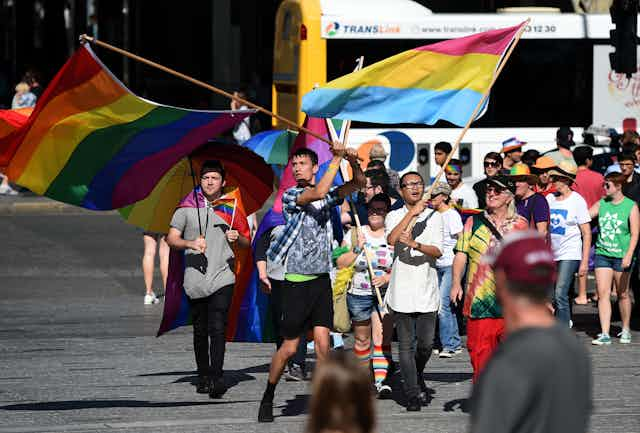Homophobia is costly to workers and the businesses that employ them, research shows. Unfortunately, it’s still prevalent in Australia and the latest lobbying from 34 business leaders for marriage equality emphasises the need for it to be addressed both within and outside the workplace.
It’s little wonder some of Australia’s leading companies called on the government to get on with the job of legislating for marriage equality. Businesses increasingly recognise that homophobia and transphobia limit their organisation’s ability to attract and retain a high calibre workforce and is hurting their bottom-line.
As CEO of Deloitte, Cindy Hook, stated
I believe in fairness and inclusion for all and my overriding aim is for every one of our people at Deloitte to reach their full potential, which includes choosing who they marry.
Smart employers know that diverse and inclusive workplaces are more profitable, innovative and have employees who are more engaged, and have a higher level of staff retention.
Homophobia is prevalent and costly
Research tells us that close to one in two LGBTI (lesbian, gay, bisexual, transgender and intersex) Australians hide their sexual orientation, gender identity or intersex status in the workplace for fear being “out” could damage their careers.
And despite Australia having some of the most inclusive anti-discrimination protections in the world for LGBTI people, most LGBTI employees in Australia have witnessed or heard of homophobic incidents at work.
Those experiencing homophobia and transphobia are likely to have decreased well-being and negative work attitudes, suggesting that homophobia and transphobia (including not recognising LGBTI relationships) can hurt the quality of work life and the general well-being of LGBTI individuals.
LGBTI individuals face barriers even before they start a job. The probability of gay and lesbian applicants being selected for a job interview is lower than it is for their heterosexual counterparts. This is especially true for those residing in areas lacking legal protection such as Texas in the United States and working in male or female-dominated industries.
Homophobia and transphobia can also have a detrimental impact on productivity and profitability. In Australia, lesbian and gay marketing specialist firm Out Now estimates the financial benefits associated with encouraging closeted workers to come out could be as much as A$285 million per year. This includes an 11% increase in staff retention and 30% improvement in the productivity of closeted workers.
Research from the US shows companies that adopt LGBTI-supportive policies achieve higher productivity and profitability resulting in a greater growth in their share price. This is compared to companies that are not supportive of their LGBTI employees. So LGBTI inclusion makes good business sense.
What should business do?
Over the past decade, companies have made significant progress towards creating more inclusive workplaces for LGBTI employees. And this is having a pay-off for all employees, as a recent review of LGBTI studies shows.
Research shows that inclusive leaders play a critical role in unlocking the benefits of a diverse and inclusive workplace. Having an inclusive leader who is a member of a minority group may reduce unconscious bias towards this minority group.
So it follows that having visible LGBTI senior leaders in an organisation could help to reduce homophobic and transphobic attitudes and demonstrate a more inclusive culture within the organisation.
Research in social psychology has also found that clear instructions to avoid stereotyping can be an effective way to reduce unconscious bias. Therefore, a firm and consistent message on LGBTI inclusion from supervisors, managers and executives, may minimise unconscious bias and stereotyping towards LGBTI employees.
Companies can also create an LGBTI-inclusive workplace by developing and implementing specific LGBTI-inclusive policies and practices. Examples of this include providing information and support to LGBTI employees (such as establishing a LGBTI network) and also making the support of LGBTI inclusive initiatives visible to all their employees, business partners and the community.
Businesses can also create diversity champions, employees who model inclusive behaviour and positive attitudes towards LGBTI employees. These champions can create a safe space for LGBTI individuals. This practice is increasingly common in sports.
Homophobia is costly to individuals, businesses and the community. Unfortunately, it is still prevalent and needs to be addressed both within and outside the workplace. Leaders, organisations and the community should work together to tackle homophobia and achieve equality.
Cathy Brown contributed to this article. She is the Policy and Research Manager at Diversity Council Australia and is also an Authorised Marriage Celebrant.

